Which septic tank is better for home: a comparison of popular treatment plants
The toilet on the street is not aesthetically pleasing, inconvenient and not environmentally friendly. To solve the problem of creating an independent sewage system, to which you can connect the whole house, special containers are installed - septic tanks.
Septic tank is used for collection, purification, sedimentation and clarification of effluents. Wastewater must not be allowed to enter the environment. This is fraught with contamination of soil, underlying rocks and groundwater.
But which septic tank is better for home and how to install it correctly? To solve these problems, we will examine the criteria for choosing factory tanks for creating an autonomous sewage system. And also consider the best manufacturers of septic tanks, which will help you choose the best option for your home.
The content of the article:
- The principle of operation of the septic tank
- Comparison of single-chamber septic tanks with multi-chamber
- Septic tanks for increased cleaning requirements
- Tips for choosing a septic tank
- Overview of the most popular septic tank models
- Septic tank manufacturers rating
- Conclusions and useful video on the topic
The principle of operation of the septic tank
Septic tank is one of the significant elements of an autonomous sewer system. Its main task is to collect and process wastewater from a house or several buildings. Processing is carried out by simple settling or more complex biological treatment.
Depending on the degree of treatment, the effluents are redirected to an additional treatment plant, discharged into the ground or into the gutter. Multistage treatment of wastewater makes it possible to dispose of the clarified and disinfected liquid component without fear of upsetting the natural balance or creating a threatening environment in the environment.
A device may include one or more storage tanks. Its body is made of waterproof materials, has a high level of waterproofing. All types of septic tanks have a receiving chamber or a separate compartment into which sewage flows by gravity through a sewer pipe.
The solid insoluble component of the waste mass settles at the bottom. Inclusions of lower density float to the surface where they are adsorbed by all kinds of filtration devices. At this stage, the stratification of effluents occurs.
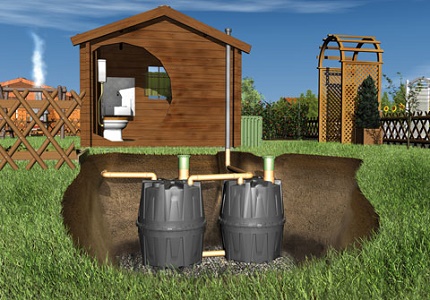
In the septic tank, a continuous process of decomposition of human waste under the influence of a complex of bacteria occurs. They contribute to the breakdown of organic substances into practically pure water, activated sludge and gases. During processing, all painful microflora die.
Next, the purified water is separated from the activated sludge, which accumulates in the sump for subsequent pumping with sewage pumps. The clarified and disinfected liquid component moves to the outlet of the septic tank by gravity or using a sewage pump.
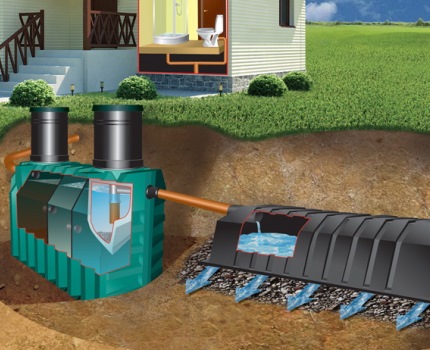
For the post-treatment and disposal of recycled waste water, the following are used:
- filter fields - represent a system of perforated drainage pipes laid in filter trenches filled with sand and gravel mixture;
- absorption / filter wells - represent a sewer well with a filter layer of gravel and sand with a thickness of more than 1 m;
- infiltrator - a factory fixture in the form of a half-turned upside down, mounted on a soil cushion of gravel and sand;
- sewage ponds and ditches - facilities intended for the accumulation and removal of water purified to 95-98% to centralized treatment facilities.
If in the area of an autonomous sewage system with a septic tank there is a developed central network, then it is better to connect to it.
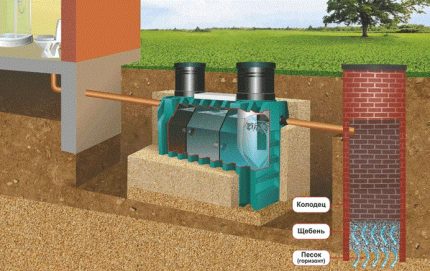
The choice of the method of soil post-treatment depends on the degree of treatment of effluents, as well as on the level of ground water and the type of soil, because:
- for normal disposal of treated water, soils, underlying post-treatment systems must have sufficient filtration qualities;
- between the conditional bottom of the infiltrator, the absorption well and the drain of the filtration field should be at least 1 m;
- According to the requirements of SES, only wastewater that has undergone biological processing and treated up to 95-98% is allowed to be discharged into sewage ponds and ditches, storm collectors according to the SES requirements.
Consequently, post-treatment systems may only be installed if sand, gravel, gravel, and pebble deposits prevail in the local geological section. Between the bottom of the structure and the level of groundwater in the spring-autumn period should be at least a meter.
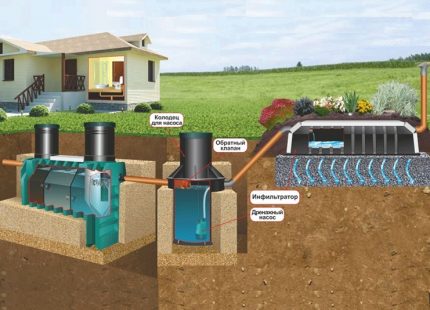
If the conditions of the site on which the autonomous sewage system is being built do not meet the above requirements, it will be necessary to look for a way to connect to the central sewage system.
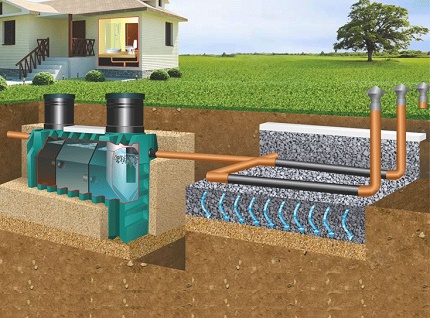
If this outlet is not available, you will have to purchase a biological treatment station, which allows you to drain the drains into a ditch, or install a storage tank that does not clean, but only collects the mass for subsequent pumping with sewage pumps.
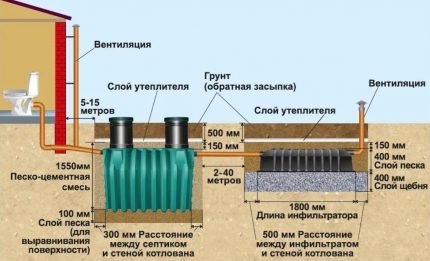
Comparison of single-chamber septic tanks with multi-chamber
Experts recommend using the installation on two cameras, because they are able to purify water much better. A single-chamber septic tank is suitable for a home where the total volume of effluents does not exceed 1 m3 of cube in knocks and excrement of feces into sewage is excluded.
If you exceed the specified volume and add fecal sewage, then a single-chamber installation will not be able to fully purify the water. The need to call a sewage machine to pump out insoluble sediment is also increasing.
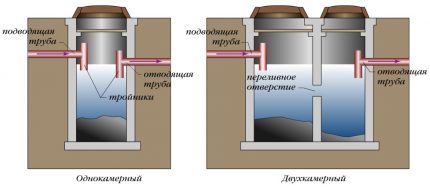
A more universal solution is multidimensional septic tanks. The majority of inclusions in the form of sediment remain in the first reservoir. Through the overflow pipe, the effluent after the initial treatment enters the second chamber.
A complete biological treatment takes place here under the influence of bacteria. All organic inclusions precipitate in a solid precipitate that cannot be separated. The gas released during this process is discharged through the ventilation pipe.
Then the water through the overflow pipe enters the infiltration device. In biological treatment plants, there are third and fourth chambers in which the final sedimentation of water from sludge is carried out. To enhance the action of aerobic bacteria, a compressor unit is often supplied to the second and third chambers to saturate water with oxygen necessary for aerobic life.
Septic tanks producing biological treatment need power supply, aswithout it, the operation of aerators and compressors is impossible. Structures that clean the sewer mass by settling are, in most cases, energy-independent. An exception are schemes in which sewage is discharged using pumps.
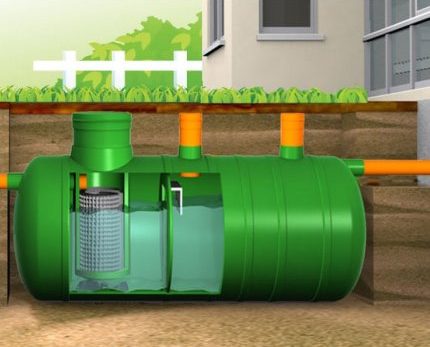
So that both chambers have the same pressure, an air channel is created between them. To audit the septic tank, they are equipped with necks with hermetic hatches.
Septic tanks differ among themselves:
- volume;
- dimensions;
- performance
- the set of materials used;
- layout and other features.
Previously, septic tanks were made on their own using reinforced concrete rings. But, in such designs it is very difficult to provide a high degree of sealing due to the large number of joints.
Today, manufacturers of engineering systems offer turnkey solutions from reliable and sealed materials. Most often, these are several cameras combined in one housing, but there is also a modular design.
Septic tanks for increased cleaning requirements
Sometimes purified water must be used for technical needs. To comply with the requirements of SES, manufacturers produce septic tanks with a biofilter. Cleansing with aerobes and anaerobes is combined with standard mechanical filtration and exfoliation, as well as chemical exposure to active oxygen.
Septic tanks with a biofilter are approaching in their indicators to a local treatment plant. The disadvantages of these installations include the high cost.
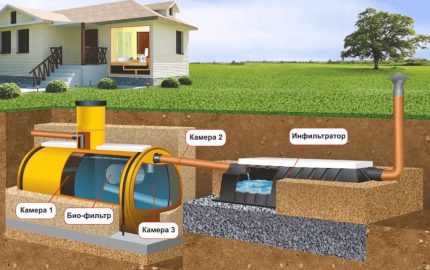
Tips for choosing a septic tank
Before buying, you have to consider a number of important nuances that are fundamental to choosing the right model. Next, we consider the main criteria in more detail.
Subtleties of choosing a place for installing the tank
Before buying a septic tank, the owner must determine the place of its future installation. In addition, the location of an impressive construction should be consistent with a number of sanitary requirements.
Failure to comply with these rules may entail the following consequences:
- penetration of unpleasant odors into the premises of the house;
- the ingress of waste and bacteria into groundwater and water sources;
- contamination of the site as a result of floods, melting of snows or showers, when the water in the tank leaves the soil more slowly, which can create a threat of flooding the septic tank and subsequent infection of the surrounding area;
In addition to the competent installation of the facility, it is necessary to perform flawless laying of the pipeline and tight connection of pipes so that untreated sewage does not penetrate into the environment without proper treatment.
In order to protect yourself from all troubles, it is necessary to adhere to several regulatory requirements:
- Consider the location of nearby water bodies.
- Consider the location of the water intake. The septic tank should be 50 meters from the well, and with sandy soil - 80 meters. The distance to the deep type well is at least 25 meters.
- The distance to the foundation is at least 5 meters, and from other outbuildings - more than a meter.
In some cases, the distance to the foundation can be reduced, but this is only in those conditions when a local cleaning station with a biofilter is used. But even this moment requires coordination.
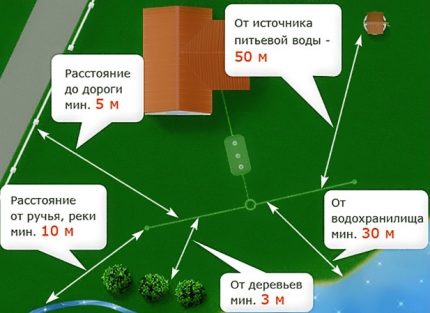
When implementing an autonomous sewage project, the distance in each case is determined individually, taking into account the features of the soil, landscape and proximity of water sources:
- there should be no trees around the septic tank at a distance of 3 meters (the roots can damage the tanks, and the ingress of organic matter can cause the death of plants);
- the structure should be located at least 5 meters from the road;
- the minimum distance to the static reservoir is 30 meters, and the river or stream - at least 10 meters;
- water pipes should be at least 10 meters from the septic tank;
- the distance to your neighbor’s site should be at least 2 meters.
Compliance with all requirements may complicate the search for a suitable place for a sewer installation. In addition, it is necessary to consider how the sewage machine in the future will be able to drive up to pump wastewater from the tank.
Installation of a septic tank is carried out as part of a previously created project, which is agreed with the SES. Construction should be carried out clearly on the project. Any inconsistencies can give rise to a number of troubles in the form of an administrative offense with unpleasant consequences.
If the sewer structure is buried below 5 meters in the ground, it will be necessary to obtain permission to install it in the local municipal organization. It would be nice to design an autonomous system in order to accurately calculate costs and plan actions.

How to choose the volume of a septic tank?
A septic tank of the correct volume will provide a high degree of purification, complete decomposition of organic substances and exclude rapid overflow of the tank. But do not go to extremes - a too large installation will take up a lot of space, will cost an order of magnitude more expensive and will entail additional labor costs during installation.
You can determine the volume of a septic tank using engineering formulas and special tables, but in order not to confuse anything, you can go a simpler way. According to sanitary standards, wastewater must be in the septic tank for at least three days. From this it turns out that the volume of the tank should be three times larger than the daily volume of effluents that the family produces.
It is enough to know how much water is consumed per family member. On average, one adult spends about 200 liters of water every day. But, this indicator may have another value, which depends on the installed plumbing equipment (shower, bathtub). It is also worth considering the presence of dishwashers and washing machines, which can trigger an increase in daily consumption.
When laying a septic tank, you need to consider future circumstances, including the arrival of guests or replenishment in the family. Therefore, it is necessary to purchase a plant with a volume of 30% more than the calculated one. The capacity of the septic tank may decrease due to the accumulation of sediment between the planned pumpings.

The layout and dimensions of the septic tank
Obviously, the size depends on the volume of the septic tank. On sale are models of various volumes, made in horizontal or vertical form. The choice depends on the available area for installation. The horizontal model will require more space, but for vertical installation, you need to dig a pit of greater depth.
The installation depth depends on the level of seasonal freezing of the soil, which is determined by the climatic zone. This information can be found in any construction organization.
With an impressive depth of freezing, it is better to stop on a vertically elongated model. The entrance and exit to the structure should be below the freezing level, which means that to install a horizontal structure, you will need not only a deep, but also quite wide foundation pit.
The main disadvantage of installing volumetric, insufficiently filled septic tanks is their ascent during the rise in groundwater in the spring-autumn period and during snowmelt. Therefore, they are installed on concrete slabs arranged at the bottom of the pit and anchored - they are attached to metal plates laid in the slabs. The vertical septic tank wins due to greater stability, requiring a concrete base of a smaller area.
When installed at a certain depth, the length of the necks through which the audit and pumping of waste is carried out must be taken into account. They should rise 18-20 cm above the day surface to prevent flooding during snowmelt.
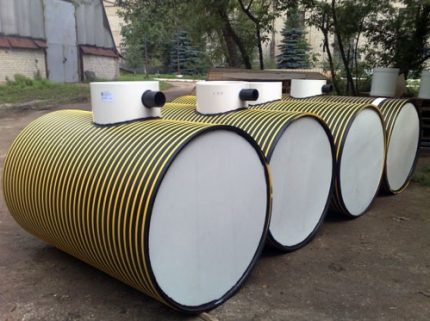
The effect of soil on the septic tank choice
The type of soil depends on the grade of the treatment plant and how the septic tank is installed:
- On the sands of all types of size and density, all types of septic tanks are installed. Similar substrates with excellent filtration properties include gravel and gravel. The systems are supplemented with any type of soil post-treatment: a filtration field, a factory infiltrator, an absorption well.
- On clay soils, storage tanks or biological treatment plants are used. Because filtering qualities of loams, sandy loam, clay does not allow for disposal into the ground, then methods of pumping with sewage pumps or dumping into the gutter are used.
If the clay soil in the underlying section is represented by a layer with a thickness of 1.0 1.5 m, it can be removed and taken out, replacing it with a gravel-sand composition. This is the only option when it is not possible to install a bioseptic.
If the aquifer in the area lies close to the surface, in any case only a storage tank is installed.
Case Material
All models on the market are divided into metal and polymer. Each of them has advantages and disadvantages.
The simplest models of polymer septic tanks have an affordable price and are not subject to flooding during floods, as equipped with anti-ascent fins.But it also complicates the transportation and installation, requiring the involvement of special equipment.
The metal tank must undergo high-quality factory anti-corrosion treatment and have a high degree of waterproofing. Otherwise, the aggressive environment will simply “eat” the tank.
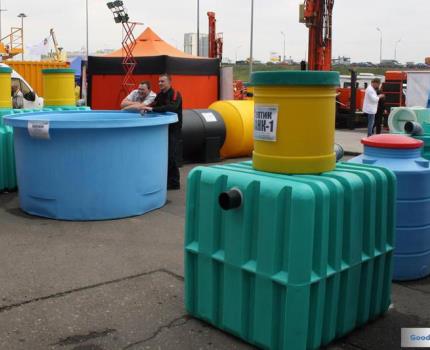
Another significant drawback is the high thermal conductivity of the metal. Sewage in such a tank can simply freeze, being even below the level of freezing of the soil. Therefore, it is necessary to mount a layer of thermal insulation using mineral wool or other material.
Plastic septic tanks are more widely used. They have a small mass, reinforced with reinforcing ribs, convenient for transportation and installation, have a completed design.
These models today are made of three types of materials:
- Polyethylene - the cheapest and lightest, almost completely devoid of seams, which guarantees a high degree of tightness. Limited to maximum wastewater temperatures (hot water can melt the enclosure).
- Polypropylene - more durable and withstand abrasive environments, do not wear out. Resistant to any temperature of wastewater, suitable for hot drains.
- Fiberglass - the most reliable and durable among polymer septic tanks. Fiberglass is resistant to aggressive chemical environments, including organic solvents. Can be used to treat industrial waste water. Have a higher price.
Polymer septic tanks serve 50 or more years. Their only drawback is the likelihood of surfacing due to low weight. Therefore, the owner needs to take care of fixing the container in the thickness of the soil.
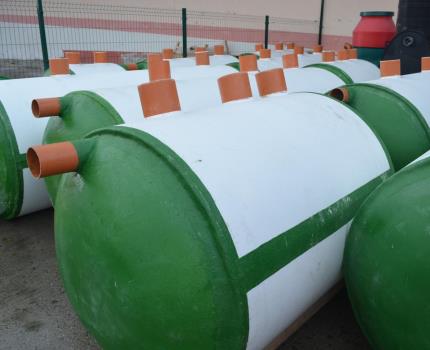
Overview of the most popular septic tank models
The Russian market is dominated by polymer solutions for the organization of autonomous sewage:
- Series "Tank». The installation with thick polyethylene walls (10-17mm), designed for 50 years of continuous operation (available in various volumes, providing the needs of 1 to 10 people). The modular design allows you to assemble several septic tanks in one installation, increasing productivity. It processes a minimum of 600 l / day with an installation weight of 85 kg;
- Series "Biotank". An autonomous treatment plant with which recycled water can be sent to the relief (the design consists of 4 chambers in which biochemical filtration and aeration take place). Available in volumes that can serve a family of 3 to 10 people.
- Series "Triton T». Septic tank of increased strength with a wall thickness of 14-40 mm. It consists of three chambers and has a connector for installing pumping equipment. The model nomenclature includes an option from 1 to 40 cubic meters, which allows serving several houses at the same time.
- Series "Topas». A sewage treatment plant producing deep biological sewage treatment (for 5-20 people). At the outlet, purified water can be sent for discharge into the ground or into a flowing type pond. The septic tank has the ability to clean sludge on its own, using a drainage pump or airlift. It is not necessary to call the sewage machine.
All types of septic tanks require periodic removal of accumulated sludge, which can be used as fertilizer or the basis for the formation of compost heaps.
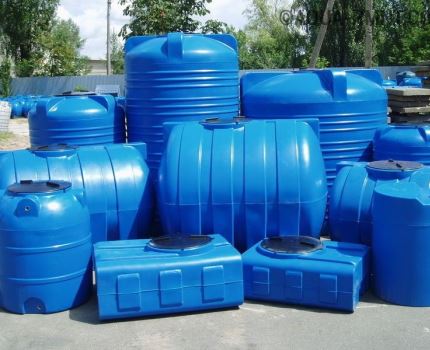
Septic tank manufacturers rating
Experts recommend paying attention to the products of the following manufacturers: Evo Stock Bio, Fast, Alta Bio, Uponor bio, Purges, Biozone and Tver. The latter are very difficult to install and require the involvement of specialists for installation.
When choosing a septic tank, be sure to consider the following advice in order to save money. If the house where you plan to install an autonomous sewage system is used only on weekends or holidays, then a full septic tank is not necessary.
Bacteria and organic compounds will die due to the lack of regular replenishment of the nutrient medium. Therefore, in this case, you can install a simple storage septic tank with the desired volume.
But, in this case, you can forget about the discharge of water into the soil layer. Despite the biodegradation and sedimentation of the effluent, you will have to call the sewer when filling the tank.
Conclusions and useful video on the topic
A video with recommendations for the purchase of a septic tank for an autonomous sewer device:
Having your own home is the dream of many people. But, it will be possible to really feel comfortable in it only if the appropriate conditions are created.
High-quality water supply and sewerage are critical conditions for comfort if the family regularly lives in the house.
Choosing the best septic tank for your home? Maybe you have questions that you would like to discuss, but we did not consider them in our material? Ask in the comments under this article - we and our website visitors will try to clarify controversial issues.
Or are you already using a septic tank and want to share your experience with other homeowners? Write your recommendations, add photos, indicate the advantages and disadvantages of your model identified during operation.

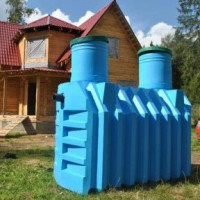 Which septic tank to choose: rating of the best sewage treatment plants
Which septic tank to choose: rating of the best sewage treatment plants  Review of septic tanks “Mole”: device, advantages and disadvantages, comparison with competitors
Review of septic tanks “Mole”: device, advantages and disadvantages, comparison with competitors 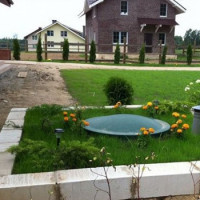 How to choose a septic tank for giving: an overview and tips for choosing the best option
How to choose a septic tank for giving: an overview and tips for choosing the best option 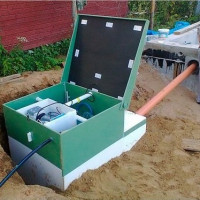 Overview of the septic tank “Eurobion Yubas”: device, advantages and disadvantages, comparison with competitors
Overview of the septic tank “Eurobion Yubas”: device, advantages and disadvantages, comparison with competitors  Septic “Uponor”: device, advantages and disadvantages, review of the model range
Septic “Uponor”: device, advantages and disadvantages, review of the model range  Do-it-yourself septic tank without pumping and odor: simple solutions for your garden
Do-it-yourself septic tank without pumping and odor: simple solutions for your garden  How much does it cost to connect gas to a private house: the price of organizing gas supply
How much does it cost to connect gas to a private house: the price of organizing gas supply  The best washing machines with dryer: model rating and customer tips
The best washing machines with dryer: model rating and customer tips  What is the color temperature of light and the nuances of choosing the temperature of the lamps to suit your needs
What is the color temperature of light and the nuances of choosing the temperature of the lamps to suit your needs  Replacement of a geyser in an apartment: replacement paperwork + basic norms and requirements
Replacement of a geyser in an apartment: replacement paperwork + basic norms and requirements
Hello everyone) If you want to extend the life of septic tanks, then be careful when choosing detergents, in the event that the water is drained from washing. cars goes to the general sewer. I switched to WAVE washing sheets, there is almost the entire composition of biological substances, so it prolongs their life - that's for sure!
Good idea for a private sector where there is no common sewage system. I have just such a problem. I re-read a lot of literature on this subject and still I can’t find the most suitable budget option. After all, it is clear that buying cheap means “driving yourself into a corner”: in a couple of decades, you will have to change the septic tank. And choosing expensive options means that you need to specifically empty the family budget.
So the insoluble dilemma turns out. Who faced the same problem as mine? How did you get out of the situation?
Good afternoon, Vladimir. Inexpensive septic tank - this does not mean bad. Pricing is based mainly on brand promotion and the availability of an electronic control unit.
From inexpensive models have proved themselves:
1. “Tver” has a horizontal shape and is suitable for high groundwater. The body is made of polypropylene with horizontal stiffening ribs. I advise you to read the detailed review on the site.
2. “Sled” has a conical shape and is suitable for heaving soils. The body is made of reinforced fiberglass. The main advantage is the integrity of the structure, the absence of welds.
Both septic tanks:
- spend most of the treatment processes mechanically;
- perform deep wastewater treatment of about 98%;
- imply that the compressors are installed in the house. A pretty good plus, in case of overflow, there will be no closure;
- do not require complicated maintenance, since only a compressor for supplying oxygen to aerobic bacteria is from electronics.
Good luck in choosing and buying!